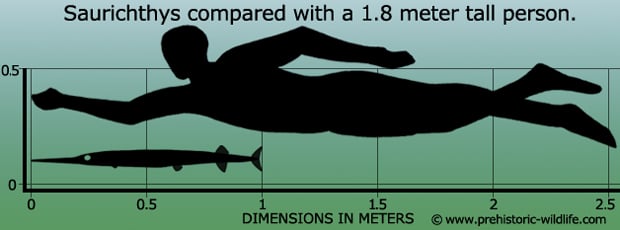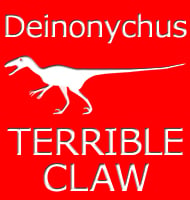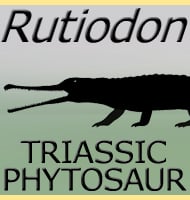In Depth
As an early ray finned fish Saurichthys displays several characteristics of a fast swimming predator, however the exact method of hunting is still not known for certain. The caudal (tail) fin was not as well developed as other open water fish, although the close proximity of the dorsal (back) and anal (bottom) fins set much further back on the body would have had a contributing effect of providing additional thrust as Saurichthys flexed its tail from side to side. Additionally the long torpedo-like body meant that Saurichthys would have faced very little resistance as it swam through the water which also suggests high swimming speed.
However it is unlikely that Saurichthys was not a pursuit predator that chased prey across open water, and this reasoning is based upon the size of the pectoral fins. Pectoral fins are essentially hydroplanes that counteract the downwards pitching effect of swimming by tail. Because the tail is on the rear of the body it pushes rather than pulls the body weight so that the main body ends up sinking without the support of fins to keep it angled in the desired direction of travel. The larger the pectoral fins, the more they can compensate and the faster the fish can swim without unavoidably pitching down. This is why the fastest swimming fish we know today have some of the proportionately largest pectoral fins.
The pectoral fins of Saurichthys however are tiny however and they would have offered very little hydroplane support in swimming. This means that while Saurichthys could combine the caudal and dorsal tail positions with the streamlined body for high speed, it could not maintain this speed over distance without pitching down for lack of support from the pectoral fins. This means that Saurichthys could only swim at speeds in short bursts, something that reveals that even though Saurichthys could not chase prey across open water, it was very well suited to the life of an ambush hunter.
Ambush hunting requires the use of cover for the predator to hide in and here the narrow body and small fins of Saurichthys would have been perfect for lurking amongst water weeds and submerged debris as it could operate in these locations without wedging its body or snagging and tearing its fins. Also while no fossil evidence exists to support this, it is reasonable to assume that in life Saurichthys would have had a mottled or striped patterning to break up the shape of its body to the eyes of prey as it lay in cover.
When prey was identified Saurichthys probably would have slowly lined itself for a strike while still in cover, constantly making fine adjustments as it watched its prey moving and approaching closer. Once Saurichthys gauged its target was within strike range it would rapidly flick its tail and use the combined push of all of its rear fins to shoot out of the undergrowth like an arrow towards its prey. Once close enough, Saurichthys could open up its elongated jaws, as much as third of the total length of the body, to seize its prey.
Saurichthys was likely a predator of fish and quite possibly other vertebrates such as amphibians. However an Italian specimen of a bolus (a collection of animal parts that are indigestible for a specific predator so they are regurgitated in pellet form) suggests that Saurichthys even included small pterosaurs in its feeding, in this case often credited as the genus Preondactylus. It is unknown if the Saurichthys in question killed the pterosaur, or was merely scavenging the carcass of a drowned individual, but it does offer a fascinating insight into the aquatic ecosystems of the Triassic.
Further Reading
– L’Infralias dans la Franche-Comt� [The Lower Lias of Franche-Comt�]. – M�moires de la Soci�t� d’�mulation du Doubs, 4e s�rie 10:287-486. – M. J. Henry – 1876. – Description d’une nouvelle esp�ce de Saurichthys du gr�s a voltz de Wasselonne. – Bulletin du Service de la carte G�ologique d’alsace et de Lorraine 2:89-97. – F. Firtion – 1934. – La faune ichthyologique de l’Eotrias du N. W. de Madagascar: le neurocr�ne. – Cahiers de Pal�ontologie 1968:1-125. – L. Beltan – 1968. – The Upper Triassic Fishes from Polzberg bei Lunz, Austria. – Zoological Journal of the Linnean Society 60:1-93. – J. Griffith – 1977. – Un nouveau Saurichthyidae (Pisces, Actinopterygii), Saurichthys nepalensis n. sp. du Trias Inf�rieure des Annapurnas (Thakkhola, Nepal) et sa significations pal�obiog�ographique. – Cybium 3e S�rie 2(4):17-28. – L. Beltan & P. Janvier – 1978. – A new saurichthyid from the Upper Permian of Zhejiang, China. – Vertebrata PalAsiatica 26(2):77-89. – X. Liu & F. Wei – 1988. – Freshwater fish fauna from the Triassic of Northern Asia. – Mesozoic Fishes 2—Systematics and Fossil Record 445-468. – E. K. Sytchevskaya – 1999. – New species of Saurichthys (Actinopterygii: Saurichthyidae) from Middle Triassic (Anisian) of Yunnan Province, China. – Acta Geologica Sinica 83(3):440-450. – F. Wu, Y. Sun, W. Hao, D. Jiang, G. Xu, Z. Sun & A. Tintori – 2009. – New Saurichthyid Actinopterygian Fishes from the Anisian (Middle Triassic) of Southwestern China. – Acta Palaeontologica Polonica 56(3):581-614. – F. Wu, Y. Sun, G. Xu, W. Hao, D. Jiang & Z. Sun – 2011. – Remains of Saurichthys (Pisces, Actinopterygii) from the Early Triassic Wordie Creek Formation of East Greenland. – Bulletin of the Geological Society of Denmark 93:93-100. – I. Kogan – 2011. – Saurichthys and other fossil fishes from the late Smithian (Early Triassic) of Bear Lake County (Idaho, USA), with a discussion of saurichthyid palaeogeography and evolution. – Bulletin of Geosciences. 87: 543–570. – C. Romano, I. Kogan, J. Jenks, I. Jerjen & W. Brinkmann – 2012. – A new species of Saurichthys (Actinopterygii) from the Middle Triassic (early Ladinian) of the northern Grigna mountain (Lombardy, Italy). – Rivista Italiana di Paleontologia e Stratigrafia 119:287-302 – A. Tintori – 2013. – A new Saurichthys (Actinopterygii) from the Spathian (Early Triassic) of Chaohu (Anhui Province, China). – Rivista Italiana di Paleontologia e Stratigrafia 120:157-164. – A. Tintori, J. D. Huang, D. Y. Jiang, Z. Y. Sun, R. Motani & G. B. Chen – 2014. – Redescription of Saurichthys madagascariensis Piveteau, 1945 (Actinopterygii, Early Triassic), with implications for the early saurichthyid morphotype. – Journal of Vertebrate Paleontology. 36 (4). – Romano Kogan – 2016. – Exceptional preservation reveals gastrointestinal anatomy and evolution in early actinopterygian fishes. Scientific Reports 6:18758. – Thodoris Argyriou, Marcus Clauss, Erin E. Maxwell, Heinz Furrer & Marcelo R. S�nchez-Villagra – 2016. – A new species of Saurichthys from the Middle Triassic (Anisian) of southwestern China. Vertebrata PalAsiatica 56:273-294. – F. X. Wu, Y. L. Sun & G. Y. Fang – 2018. – Internal cranial anatomy of Early Triassic species of Saurichthys (Actinopterygii: Saurichthyiformes): implications for the phylogenetic placement of †saurichthyiforms. – BMC Evolutionary Biology. 18 (1): 161. – Thodoris Argyriou, Sam Giles, Matt Friedman, Carlo Romano, Ilja Kogan & Marcelo R. S�nchez-Villagra – 2018. – Re-evaluation of the ontogeny and reproductive biology of the Triassic fish Saurichthys (Actinopterygii, Saurichthyidae)”. Palaeontology. 61: 559–574. – Erine E. Maxwell, Thodoris Argyriou, Rudolf Stockar & Heinz Furrer – 2019. – A new species of Saurichthys (Actinopterygii: Saurichtydae) from the Middle Triassic of Monte San Giorgio. – Rivista Italiana di Paleontologia e Stratigrafia. 127 (1): 49–71. – S. Renesto, F. Magnani & R. Stockar – 2021.









